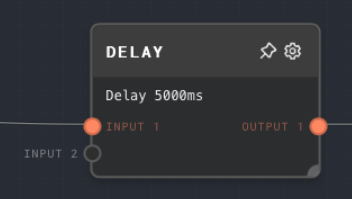Delay Node

Overview
The Delay Node is used to introduce a delay in the execution of the graph. It takes any number of inputs and after a specified delay, passes the input values to the outputs without any modifications. This node is useful when you need to control the timing of your graph's execution.
- Inputs
- Outputs
- Editor Settings
Inputs
| Title | Data Type | Description | Default Value | Notes |
|---|---|---|---|---|
| Delay | number | The delay time in milliseconds. | 0 | This input is only available if the "Use Delay Input" setting is enabled. |
| Input [i] | any | The ith input that will be passed to output. | N/A | Dynamic number of inputs based on how many connections there are. |
Outputs
| Title | Data Type | Description | Notes |
|---|---|---|---|
| Output[i] | any | The ith output from the execution of the delay node. | The output will be the same as the corresponding input after the specified delay. |
Editor Settings
| Setting | Description | Default Value | Use Input Toggle | Input Data Type |
|---|---|---|---|---|
| Function Name | The delay time in milliseconds. If the "Use Delay Input" setting is not enabled, this value will be used as the delay. | 0 | Yes | number |
| Use Error Output | If enabled, then the Delay node will use the "Delay" input as the delay time in milliseconds. If disabled, the delay time specified in the "Delay" setting will be used. | False | No | N/A |
Example 1: Delaying a Message
- Create a Text node and set its value to "Hello, World!".
- Create a Delay node and set its "Delay" setting to 5000 (5 seconds).
- Connect the output of the Text node to the first input of the Delay node.
- Run the graph. Note that the output of the Delay node is not displayed until after 5 seconds.

Error Handling
The Delay node cannot error under normal circumstances. If the delay time is negative, it will be treated as zero.
FAQ
Q: What happens if I set the delay time to zero?
A: The Delay node will pass the input to the output immediately, effectively acting as a pass-through node.
Q: Can I use the Delay node to throttle API calls?
A: Yes, you can use the Delay node to throttle API calls. For example, if you have a graph that makes an API call every time it is run, you can use the Delay node to ensure that the API call is not made more than once every 5 seconds.